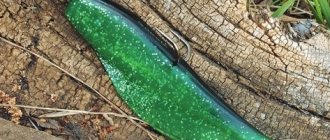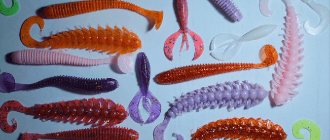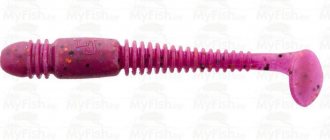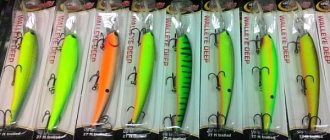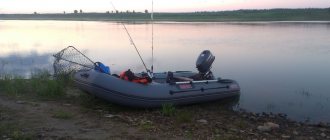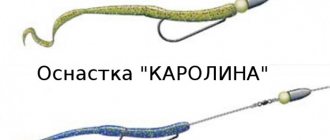Silicone baits are the most affordable type of artificial bait, in contrast to expensive wobblers and spinners. Moreover, silicone baits can be made independently, having only a mold and melted silicone.
Fishing silicone baits appeared about fifty years ago, but have gained a foothold in our markets relatively recently. But it is worth noting that their popularity is growing all the time, which makes fishermen very happy with a huge range of new baits.
Silicone baits come in various shapes and sizes, ranging from the most common fish and worms to crustaceans with claws. Silicone is the main jig bait, and is divided into several types - twisters, vibrotails, worms and silicone imitating various crustaceans, frogs, squids and other small animals.
If you want to know other baits for catching predatory fish using a spinning rod, we recommend reading about the types of wobblers.
Types of silicone baits
- Vibrotails
- Twisters
- Silicone worms
- Silicone crustaceans
- frogs
- Squid
Vibrotail is a silicone bait that imitates a small fish. It has a special “patch” on its tail, which gives the bait its active play. In other words, vibrating tails have their own game, which ensures effective fishing with even fishing.
Twister is an active silicone bait, which is quite similar to a vibrotail, its main difference is a curled tail instead of a “pigtail”. Although the twister does not look so much like a fish, in terms of efficiency this does not make it worse than a vibrotail. Both baits can be effective in different ways in different situations.
Silicone worms - in most cases, are passive baits that do not have outstanding forms, and therefore do not have their own game. Their main difference is their length, which can reach thirty centimeters.
Although a silicone worm is a passive bait, sometimes fishing with it is even more effective than using twisters and vibrotails.
Trolling technique for catching pike perch
To choose tactics for catching pike perch by trolling, first examine the reservoir. This can be done using an echo sounder; it will help you select the optimal depth and locate places where fish accumulate. Fishing technique:
- All the necessary equipment is placed in the boat and sailed 10 m from the shore. Then the spinning rod with bait is cast, and the rod is attached to the holder.
- You need to move along the shore by boat at a speed of up to 2-3 km/h. Otherwise, if the speed is high, the bait will go to the bottom, and if the speed is too low, it will settle at an average depth. When fishing for pike perch, the optimal diving depth should be more than 3 m.
- The speed of the boat is chosen depending on weather conditions. In spring, fish can be caught at a speed of 2 to 4 km/h. In the fall, trolling for walleye is done at a slow speed, but experiments can be done.
- In order not to miss the prey, hooking is done with sharp movements on a large scale.
- If you install several spinning rods with different wobblers, the chance of catching will increase by 2 times.
- To prevent the wires of the baits from getting tangled with each other, casting is done at different distances from each other. The approximate distance varies from 20 to 50 m.
Summer trolling for pike perch differs from the rest in its good bite. Especially in early June, when spawning ends. During this period, the fish are hungry and can be caught with small artificial baits. Professional fishermen advise catching pike perch by trolling at night in hot weather (July and August). During this period, the fish becomes inactive.
How to plant a silicone crustacean
When fishing on the bottom, another type of silicone is used - crayfish. In terms of shape, crayfish are the most complex silicone baits, which have claws, a tail, legs, and even antennae, which are often bitten off by predators when they attack the bait. The play of small silicone crustaceans is quite active, which attracts an active predator well.
Installation of silicone baits
- Retractable leash
- Texas rig
- Carolina rig
- Dropshot
Trolling lures. Wobblers, silicone, spinners, rigs
After you are fully equipped for your first (or maybe not exactly your first, but still...) trolling fishing trip, you should take care of putting together a box of trolling lures.
In this matter, it is worth considering both the basic principles that trolling preaches and the subjective nuances. Such as the type of the main alleged predator in the fishing area, the depth and speed of the river flow, the degree of snags in the reservoir and simply the personal preferences of the fisherman.
The main types of fish that trollers hunt are pike, pike perch, perch, and catfish.
But with the right approach to trolling, you can also successfully catch chub, ide, asp and other fish.
The main lures for trolling are wobblers and jerks, heavy spoons, vibrating tails, octopuses and twisters on fairly heavy jigs, and even spinners. Since there are a great variety of baits, we will go over the principles of choosing and using each type and recommend several working models with which to start.
The leaders among trolling lures are a variety of wobblers . It is important to understand that ordinary wobblers, which are used in casting fishing, are not suitable for trolling. A wobbler for trolling must work stably and play at solid speeds that reach 7-10 km/h. Don’t lose your attractiveness for fish on a uniform retrieve, which is what trolling is. This imposes certain obligations on the structure of the bait - the shape of the body and blade, the materials from which the wobbler is made, aerodynamic characteristics and many other factors.
In short, there are regular wobblers and there are wobblers for trolling. For example, twitch minnows such as orbit and rudra are not suitable. Still, mostly these will be rather large and potbellied cranks, shads, and minnows with their own game, which give powerful vibrations under water.
Based on the fact that trolling fishing is usually carried out at great depths and the largest predator is caught, it is worth starting with medium and large diver wobblers.
Unforgettable classic:
Cranky
When choosing a crank, like any other wobbler, you need to focus on the diving depth of the wobbler, secondly, on the size and play of the wobbler, and only then think about the color. So let's start from top to bottom.
For depths of up to 2-3 meters, JACKALL D CHERRY is ideal, as it works perfectly on a regular basis and has a sweeping and stable game. A rather small wobbler, but it showed excellent performance when trolling for asp chub and medium-sized pike and perch.
For deeper places, YO-ZURI 3D CRANK is suitable - a realistic game that will not leave a single predator alone. From pike to asp. Along with the realistic game, there are acidic, attack-provoking colors. Depths up to 4-5 meters.
TSURIBITO DEEP CRANK is an excellent wobbler for trolling along edges and pits up to 6 meters deep. Selection of zander and pike.
For the deepest bodies of water, I recommend the SALMO “PERCH” deep-water version (SDR), the largest of which dive to a depth of more than 10 meters - ideal for trolling! Catches the largest seasoned specimens of pike, catfish, and deep humpback perch.
The compact and heavy wobbler has helped hundreds of anglers out. Editor's Choice.)
Shads
The shallowest shad for a troll, which sometimes shoots like a cannon, is the YO-ZURI 3D SHAD. Chub and other relatively shallow fish are crazy about this “baby”.
STRIKE PRO CLASSIC SHAD works well for autumn pike at depths from 2 to 4 meters.
RAPALA SHAD RAP, with a depth of up to 6 meters and the largest model weighing almost 10 grams, was loved by freshwater inhabitants immediately from the moment it appeared on the market.
Among the trolling minnows, I would like to mention the YO-ZURI Cristal Minnow of the DD series. This 130 mm handsome guy dives to a depth of 7-8 meters. But you can fish perfectly in the horizon of 4-5 meters. Slower speed, shorten the cord and go into battle!
General recommendations for choosing the color of a wobbler are as follows: when fishing at relatively shallow depths in clear weather, natural dark colors catch well. If we fish in muddy and deep water up to 6 meters or more, or in poor lighting, we need to use wobblers - parrots or provocateurs. Which, by the way, is very noticeable on deep-sea wobblers for divers.
In fact, there are a great many wobblers for trolling and a little more. The eyes are not enough to take in all the diversity. A beginner should choose several models that will cover the entire horizon of depths from 2 to 8 meters in several form factors and colors, without being scattered over the entire scattering of baits. The main general points for choosing trolling wobblers are outlined, specific models are proposed.
Let's move on to other types of baits, which are not so popular among trollers, but are sometimes no less effective than wobblers.
Silicone lures for trolling. Not so long ago, this type of bait formed the basis of a troller’s arsenal. The advantages are obvious - high-quality baits made of soft silicone play well on a uniform retrieve, the depth of penetration is easily selected using the appropriate weight of the jig head, less snagging on snags compared to wobblers and less expensive.
So, what you need to know about trolling silicone.
When choosing silicone, you need to pay attention to the quality of the bait. It should not be oaky and play well on even wiring. That is, have a big penny, like a vibrotail, or a tail, like a twister. Usually slugs, worms and the like are not used. The second is size. Like wobblers, fairly voluminous silicones are selected for the troll.
And everything couldn’t be simpler; silicone is the hardest thing to make a mistake with.
Lures from Mann's have proven themselves well, for example the 10-centimeter Manns predator maximus, Relax Hoof 4, Bass Assassin and other fairly large silicone baits.
Long and flexible silicone performed especially well on pike perch and river pike.
Pay special attention to the equipment of such large baits. A simple jig head is not enough - fish, especially pike, will cut off the tail of baits equipped in this way. Therefore, fishermen came up with a variety of equipment for large silicone fish. With additional tees, non-hooking offset hooks and other variations on the theme. For example, like in the picture below. I think the point is clear.
In terms of colors, the same observations as for wobblers. Experiment and you will be happy!
The next huge layer of trolling lures are oscillating spoons . Long gone are the days when there were three lures in three sizes and colors on the market. Nowadays there are entire lines of trolling spoons from fishing tackle manufacturers. Despite idle opinions, the iron, when fed correctly, will destroy both wobblers and rubber combined. Oscillating spoons are especially good for trolling in the autumn in already cold water when catching pike, pike perch, salmon, pike and many other predators.
ON THIS TOPIC. Great video from the Shcherbakov brothers on trolling
Heavy and narrow spoons are used, which with the help of their own weight reach a given depth. Pike-perch especially loves such spoons, and if it is he who is the object of fishing, then start with them!
For example, try Michigan Stinger Spoons, an excellent selection of narrow spoons that walleyes love.
If it is necessary to deliver the bait to a sufficient depth, you can use all kinds of deepeners and downriggers.
Other spinners will be a good choice, from Soviet queens, atoms and noriches to meps cyclops and even heavy castmasters.
When choosing hardware for trolling, you need to follow only one rule. The vibrator should be compact and quite heavy, made of thick-walled metal.
With the color scheme, the same observations as for the wobbler. Only even less critical. An old copper Norwich, weighted with solder, caught both in cloudy weather at sunset and on a clear, hot day. What is more important is the action of the bait, and its color.
Spinner baits are perhaps the best bait for uniform retrieve with wide amplitude jerks to the sides, which has a good effect on the number of bites.
Well, the last, least popular option for trolling bait is a rotating spoon .
It is easy to understand that spinners can only be used with deepeners; without them they will simply be thrown to the surface. This is the essence of this bait. This does not apply to front-loaded spinners, but they cannot be used in trolling, since they are exclusively jigging baits without normal trolling action.
Of the turntables with a core, provided that deepeners, downriggers and similar devices are used, almost any of sufficient size will do. The only thing worth considering is the shape of the petal. It is preferable to use spinners with a narrow blade.
For example, Mepps Aglia Long 4-5 numbers, weighted Mepps Aglia Long Heavy, Mepps Plain Giant Killer, large turntables from Myran - Mira, Akka Hot and others.
You can also use rigs with dead fish, live bait and various homemade baits in trolling. But this is more like an opportunity to drink from a teapot through the neck. You can, but be careful! Try it if you want, but start with the bare minimum.
In conclusion, it is worth noting that many anglers are experimenting, and with some success, with various combinations of trolling lure rigs. A wobbler complete with silicone, a spinner and a spinner on two leashes and many other options. Whoever seeks finds, and whoever catches...catches!)
Good luck in conquering the peaks of trolling. May the fish be with you.
The best silicone baits
Even the most experienced spinning fisher goes through a long journey in search of an effective silicone bait. After all, the range presented in fishing stores is simply impressive. And over the past couple of years, the range has especially expanded, which is associated with an increase in demand for silicone. There are a lot of companies producing silicone baits in the world, and it’s quite difficult to find out who is capable of what, but we have created our own rating of the best silicone baits.
BeTanCo by Bait Breath
Fish Tail by Bait Breath
Polaris by Crazy Fish
One'up Shad by Sawamura
Sexy Impack from Keitech
Cruel Leech by Crazy Fish
OSP DoliveCraw 2
Ring Shrimp by Reins
Floating edible rubber
Manufacturers of edible rubber
- Lucky John;
- Keytech;
- Reins;
- Crazy Fish;
- Molix;
- Microkiller.
Fishing in winter with edible rubber
These special baits are attached through the head, placing the hook tip into the abdomen. An important point is to select a jig of the appropriate size: one that is too small and has the same small hook will not work properly with edible bait. The hook can be significantly larger than the jig.
For catching various predators (pike, perch, pike perch, trout), Hogy Hog, Rock Craw, Tioga are also good in the winter season from ice, with large jigs. The Tioga model is a special bait made specifically for hunting perch and pike perch. Recently, it has become increasingly popular among fishermen.
Thanks to the original shape of the body, during movement the bait creates vibrations in the water column that attract fish, and the side ribs make the action of the bait even brighter and more natural. Tioga has a mackerel scent that is very attractive to the above mentioned predators. In winter, small baits are used for ice fishing using a jig.
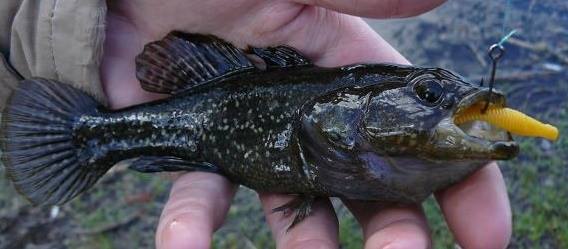
Edible rubber (video)
Color of silicone lures
The topic of choosing colors for silicone baits came up quite often. Some fishermen believe that the color of the bait does not matter, while others, on the contrary, believe that the catchability of baits very much depends on its coloring. But in fact, the color of the bait plays a role, for example, colors that work well for pike perch may not work well for pike, but in any case, you need to try all the colors yourself.
Predator preferences are influenced by weather and water clarity, so always take your entire colorful arsenal of silicone with you.
Installation of trolling gear
Depending on the conditions of the reservoirs in which fishing is planned, the gear for catching pike perch must be durable. Because uneven surfaces, underwater snags and stones for gear are dangerous for hooking. Fishing rod equipment:
- Choose a short fishing rod with a fast action.
- It is also equipped with a multiplier reel and a metal leash. It is better to use a titanium or Kevlar leash. This flexible and thin product looks like fishing line and is particularly durable. Pike perch is a toothy fish and easily bites the fishing line during attacks. But with a metal leash it will be difficult to do this.
- Some Chinese fake wobblers cannot cope with strong currents and are unable to sink to the bottom on their own. Therefore, the fishing rod is additionally equipped with a sinker. The simplest deepening agent is sinker. It has a flat shape and is mounted at an angle.
To make the catch more effective, install a drop shot. This is a retractable leash, which consists of a fishing line with an end weight, a metal leash and a sinker. The end load is chosen in the shape of a pear or ball. To give the tackle flexibility, the leash is tied to a triple swivel. Having retreated 50 cm upward, sinkers are tied to it. Thanks to this equipment, the leash will not twist while moving. The bouncer has a more rigid design. It looks like a retractable leash. In this rig, the wobbler is attached to a spring wire.
Floating silicone baits
A regular solid silicone bait will sink if placed on water, and the idea behind floating silicone is to make the silicone buoyant.
Positive buoyancy of the bait is achieved by adding light material to the bait, for example, polystyrene foam or polystyrene foam.
To make a silicone bait buoyant, you need to push a piece of polystyrene foam of the appropriate size into it, which would allow the silicone bait to float, or just slowly sink. To choose the right piece of polystyrene foam you need to experiment.
Product form
Molds for silicone baits are completely different and this is not surprising because each type of fish needs to find a certain approach. What may attract pike may not be very appealing to pike perch, etc.
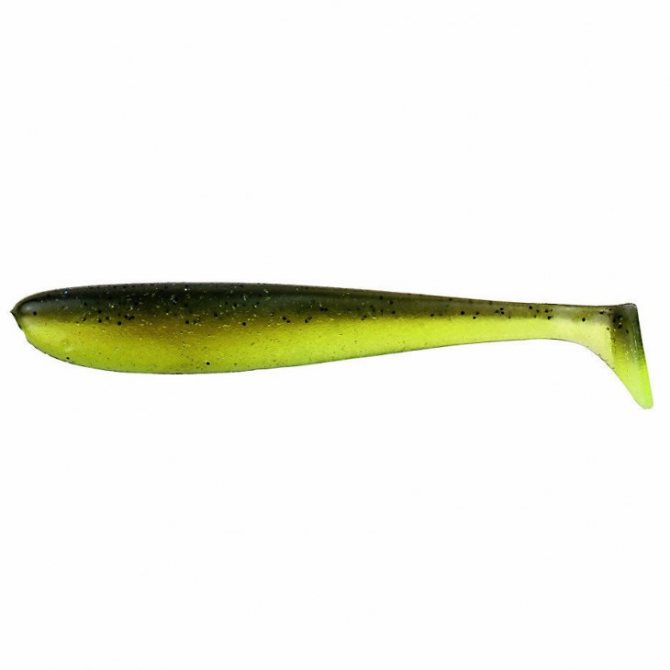
Today in specialized stores you can find the following forms:
- Slugs. A precisely made imitation of a small fish. When fishing, it plays a passive role;
- Vibrating tails. The bait is in the form of a fry with a flat-shaped tail, which is located perpendicular to the rest of the body;
- Frogs. Special models that are made with paws or rubber fringe. Can be either passive or active bait;
- Twisters. A bait with a cylindrical body and a soft, sickle-shaped tail;
- Creatures. Lures made in the most unusual shapes. Most often it is a copy of some river or sea creature;
- Worms. An artificial analogue of a worm that copies it very reliably. The latest models are equipped with tails, which also serve as a bait element.
Read here Fly fishing - a description of the technique and secrets of fishing with a spinning rod and fishing rod (130 photos + video)
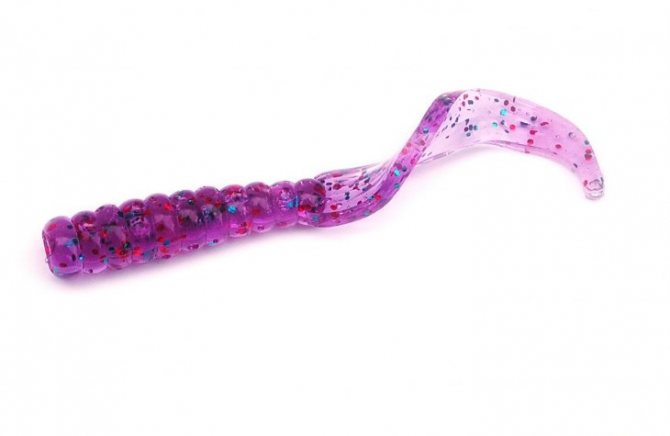
Vibration tail tuning
Many fishermen, wanting to improve the catchability of a vibrotail, resort to tuning the bait. Refinement can be carried out in several directions.
- Sometimes it is possible to increase the number of bites by painting. For this purpose, it is useful to carry waterproof markers with you. For example, if you make the back of the rubber black and draw a red dot on each side in the head area, then the predator will attack the bait more often.
- There are several ways to improve tail play. The easiest way is to make longitudinal or transverse cuts at the tail constriction. A similar effect is achieved by drilling through holes in the narrowing. You can thin the narrow part of the tail by stretching it. It is enough to immerse the vibrating tail in boiling water for a couple of seconds to stretch the rubber. After this, you should immediately cool the silicone fish in cold water.
- You can make a symbiosis of the moving body of a twister with the tail part and hoof of a vibrotail. Installation is easy with matches or instant glue.
- Experienced fishermen have noticed that the predator responds better to vibrating tails that have positive or neutral buoyancy. This can be done by introducing polystyrene foam or construction foam into the body. In the case of foam plastic, the volume of the foreign body can be precisely selected. The body is cut, a foam plate is inserted into it, and then the damaged rubber is glued or soldered. Injecting polyurethane foam looks simpler. First, a hole is drilled in the body, and then the gun is inserted and the extruder is inserted at a minimum feed. After a couple of hours it will harden, the excess can be cut off with a knife and the vibrating tail can be tested. Ideally, it is desirable to ensure that the bait hangs in the water column.
Vibrotail is one of the simplest and most affordable artificial baits. If you choose the right tires for the conditions of the reservoir and perform the appropriate wiring, you will have a real chance of catching fish. And if the predator doesn’t like the bait in some way, then it can be modified right while fishing.
